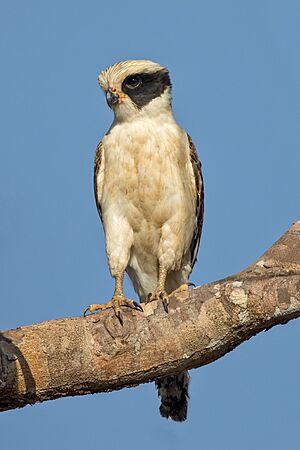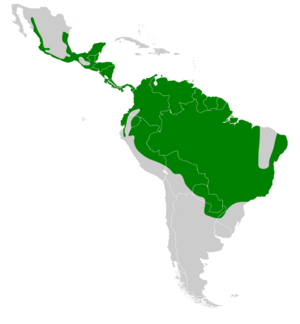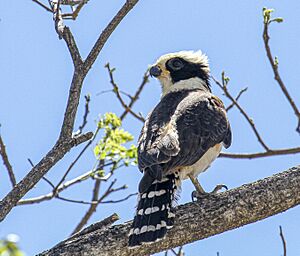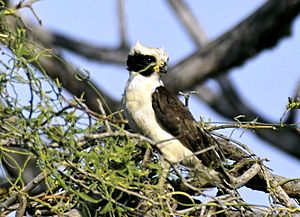Laughing falcon facts for kids
Quick facts for kids Laughing falcon |
|
|---|---|
 |
|
| Conservation status | |
| Scientific classification | |
| Genus: |
Herpetotheres
|
| Species: |
cachinnans
|
 |
|
| Synonyms | |
|
Falco cachinnans Linnaeus, 1758 |
|
The laughing falcon (Herpetotheres cachinnans) is a medium-sized bird of prey. It belongs to the falcon family, which includes falcons and caracaras. This bird lives in many places. You can find it from Mexico down through Central America. It also lives in most South American countries. Only Chile and Uruguay do not have them.
Contents
About the Laughing Falcon's Name
The laughing falcon was first described in 1758. This was done by a Swedish scientist named Carl Linnaeus. He gave it the scientific name Falco cachinnans. Later, in 1817, a French scientist named Louis Pierre Vieillot created a new group, or genus, for it. This group is called Herpetotheres. The laughing falcon is the only species in this group.
The name Herpetotheres comes from ancient Greek words. It means "reptile" and "to mow down." This name describes what the bird likes to eat. The English name "laughing falcon" comes from its loud calls. The scientific name cachinnans also means "laughing aloud" in Latin.
What Does the Laughing Falcon Look Like?
Laughing falcons are about 45 to 56 cm (18 to 22 in) long. Their wings can spread out 79 to 94 cm (31 to 37 in) wide. Female falcons are a bit bigger and heavier than males. Males usually weigh between 408 to 686 g (0.9 to 1.5 lb). Females are heavier, weighing 590 to 800 g (1.3 to 1.8 lb).
Both male and female laughing falcons look similar. They have creamy white feathers on their belly. They also have a wide, dark "mask" on their face. This mask goes around their neck like a collar. Their head has dark streaks, and they have a small crest at the back. Their wings and back are dark. Their tail is also dark with white bands.
When they fly, you can see a reddish patch under their wings. Their shape in the air looks more like a hawk than a falcon. They have short, rounded wings and a long tail. Young laughing falcons look much like adults. They might have lighter edges on their back feathers.
Where Do Laughing Falcons Live?
The laughing falcon lives in many places. You can find it from southern Mexico through Central America. It also lives in northern Colombia, Venezuela, and Brazil. Its range extends east of the Andes mountains. This includes Ecuador, Peru, Bolivia, and Paraguay. It also lives in northeastern Argentina.
These birds like open areas with trees. They avoid very dense forests. You can find them in different types of forests. They also live in savannas and other open areas with some trees. They usually live in lowlands, close to sea level. Sometimes, they can be found higher up. For example, they live up to 1,850 m (6,100 feet) in Costa Rica. In Colombia, they can reach 2,400 m (7,900 feet).
Laughing Falcon Behavior
How They Fly and Perch
The laughing falcon flies slowly. It flaps its wings quickly and then glides. It rarely soars high in the sky. When it lands, it often flicks its tail up and down. These birds often sit on a branch for a long time. They sit upright and watch the ground carefully. Sometimes, they nod their head or move a little on their perch.
Movement and Home
Laughing falcons do not migrate. They stay in the same area all year round.
What They Eat
Laughing falcons mostly eat snakes. This includes dangerous snakes like coral snakes. They can even eat large snakes! In some areas, they also eat lizards, small rodents, bats, and fish. Sometimes, they might eat birds or centipedes.
They usually hunt from a high perch. They drop down or pounce on their prey. You can often hear a thud when they catch something. They carry their food to a perch to eat it. Small snakes are swallowed whole. Larger items are torn apart before eating.
Reproduction and Life Cycle
The breeding season for laughing falcons changes depending on the area. In Guatemala and Costa Rica, they lay eggs in February and March. This is early in the dry season. In other places, like Venezuela, they breed in September. They usually build their nests in tree holes. These nests can be as high as 30 m (100 ft) above the ground. They might also use rock cracks or old nests from other birds.
They usually lay one egg, but sometimes two. Only the female bird sits on the eggs. This takes about 40 to 45 days. The young birds leave the nest about 55 to 59 days after hatching. Both parents take care of the baby birds.
Their Famous Calls
The laughing falcon is known for being very noisy. Its main call is a long series of loud, hollow notes. It often starts with a bubbly laugh. Then it makes a series of "wah" sounds. These sounds get higher and louder. People describe this call as a "wah wah" or "ha...ha...ha."
When a pair of falcons is nesting, they sing together. The female makes an "au-au-auu" sound. The male answers with "wah-koh, wah-koh, wah-koh." These calls help the pair bond together. Their calls are so unique that they give the bird its name. In some Spanish-speaking countries, it's called halcón guaco or guaicurú.
Laughing Falcons in Culture
The Ch'ol Maya people in Mexico have special beliefs about the laughing falcon. They think the bird can kill venomous snakes. They also believe these birds are healers. They can cure themselves if a snake bites them. Some Tzotzil healers even copy the falcon's call to help cure snake bites. There is also folklore that says the laughing falcon can predict rain.
Conservation Status
The IUCN (International Union for Conservation of Nature) says the laughing falcon is of "Least Concern." This means it is not currently in danger of disappearing. It lives in a very large area. There are at least half a million adult birds. Even though the number might be going down, there are no big threats right now. In fact, their numbers are often higher in disturbed forests than in untouched forests.





